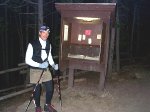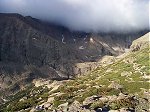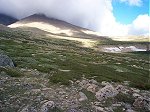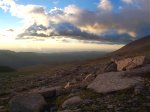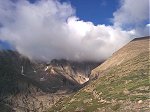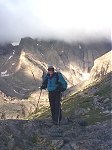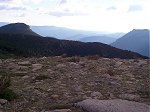Trailhead
Trip Reports
Photo Essays
Map of Hikes
Hike Calculator
List of Links
Why I Hike
Echo
Mountain Towns
Warning
Misc. Photos
Photo Credits
F A Q
Trip Reports
Photo Essays
Map of Hikes
Hike Calculator
List of Links
Why I Hike
Echo
Mountain Towns
Warning
Misc. Photos
Photo Credits
F A Q
Please click on the mountain images at the top or bottom of the page to navigate this site. Sorry for this temporary inconvenience.
Starting Elevation:
9,400 feet
Highest Elevation:
~ 12,800 feet
Distance (round trip):
~ 14 miles
click on each photo to view a larger image
John, my next door neighbor suggested that we leave for the Long's Peak trailhead at Midnight - and I knew he was serious. John is hiker's hiker - the type of guy I look up to in regards to seriously committing himself to a hike or climb. This guy just got back from Mount Rainier and is already planning a trip to one of several mountains in either South or Central America next year. Instead of me being the expert as I usually am, today I would be looking to John for leadership.
Located near the southeast corner of Rocky Mountain National Park, just about 6 miles north of Allenspark on Highway 7, there is a well-marked road leading west into the Park with signs clearly displaying the words Long's Peak. Arriving at the trailhead parking lot around 1:30 a.m., we were both surprised to see two other parties of hikers preparing for their days' journey while sitting on the trunk of their cars.
After we performed our pre-hike ritual of lacing up the boots and checking the contents and zippers of our packs, we were even more surprised to discover that the register near the trailhead indicated that we would be the 20th and 21st hikers up the mountain that night (since midnight). It is no secret that Long's Peak is an extremely popular hike but 19 people up the mountain before us (leaving the trailhead at 1:45 a.m.)? C'mon, give me a *%$@?* break!
Obviously, for night hiking you need some sort of light so that you can see the trail ahead of you. While John wore a full-blown Petzl headlamp, I was more than content with my Maglight and headband. As luck would have it, there was no moon to add additional ambient light to the scene, but on the plus side, our trip happened to occur one day before the climax of the Perseids meteor shower.
Hiking through the night, John and I kept a quick pace which in turn lead to us overtaking most of the other people ahead of us on the trail. Night hiking can be a very Zen experience (which I won't go into) but can also be mysterious, creepy, exhilarating, and very fulfilling. For at least the first several miles of the hike, the trail is extremely well maintained - it probably has to be due to the heavy amounts of traffic which this path receives. The trail was wide and overlaid with a layer of fine gravel which has subsequently been ground to a virtually smooth surface. Frequent waterbars cross the trail thus forcing you to pay attention when traveling at a quick pace in the dark. Our lights only illuminated a small area in front of each of us so whenever a sound was heard off to the side of the trail you had to choose between stopping to turn your head (and light) to look for the sound or continuing on the journey not knowing whether or not the sound was created by a field mouse or a black bear. Periodically, we could hear a gust of wind coming through the trees as we continued through the darkness up the trail.
Eventually we came up and out of the trees and now a beautiful clear, star studded sky was visible almost all around us. While it is not wise to remove your eyes from the trail to look up at the sky while hiking at night, I still happened upon no less than three shooting stars (meteors) seen either by my peripheral vision or during brief rest stops. The lack of trees resulted in an increase in the wind. By now the wind was constant and it wasn't as warm as it was back at the trailhead. When we stopped to re-dress for the weather, I added a wool cap, ski goggles, fleece glove liners, and a light jacket to break the wind. I was still wearing shorts as I thought I could tough it out. [John by now was dressed similarly but he wore running tights on his legs.] Onward and upward we continued. Below us we could see the lights from the other hikers snaking along an invisible path up the mountain.
As we crested a hump or saddle (see photo below) which led to the (famous) Boulderfield, the wind blew even harder - so much so that on one occasion the wind knocked me off balance and I ended up catching myself by performing a reverse push-up to keep my face and torso from smacking into the rocky ground. Although it was still pitch dark, soon we could begin to make out the silhouette of the tents of overnighters camped in the (famous) Boulderfield. We now noticed that the stars were no longer visible in the direction we were headed. Clouds obscured our view of the upper reaches of the mountain from well below the Keyhole.
I guess I'm not as tough as I thought I was because by now I was freezing! I had already experienced numbness in all of my fingers so as we were in a relatively flat spot (with no cover) amid the (famous) Boulderfield, I told John I needed to take a break to add another layer. With the wind threatening to scatter anything I removed from my pack, I had to be extra careful while changing clothes. After a difficult struggle, I managed to get my winter/wind bibs on while somehow removing two layers on top so I could place my bib straps between the appropriate layers. Because I carried it all of the way up here and it was in my pack, and since I was still cold, I added another fleece to my upper layers resulting in three layers on top. Remember, I did all of this in the dark with a flashlight strapped to my head in a steady wind of 40 mph + (?). I was proud of the fact that I had lost nothing to the wind - and, I was finally warm again!
During my clothing struggles, I could see the headlamps of several other hikers taking a break nearby. I can't even begin to describe what it feels like to be high up on a mountain, in the dark, with winds so strong that you have to yell so that your hiking partner standing right next to you can make out your words. Talking to strangers high up on the mountain in the dark is a weird experience - you can't look at their face because if you do you would blind them with your light and vice versa. One member of this other hiking party came over to talk about the situation - should we (or anyone) continue on up towards the keyhole or should we call it a day? [It was still only around 5:00 a.m.] I directed this person over towards John as by now I could tell he was becoming frustrated due to the fact I took so long to change my clothes. I'm not sure what John said to this other person but the three of them disappeared into the darkness back down the mountain. Of course, we pressed on.
Since this was my first time up this mountain, I relied heavily on John's experience as he has summited Long's Peak eight times prior. We scrambled through the (famous) Boulderfield and began to climb up towards the keyhole. The wind continued unabated and gusts would either turn us around due to the force on our packs or practically remove us from our feet. After gaining only about another 100 feet of vertical we decided it was time to re-evaluate the situation while trying unsuccessfully to hide from the wind by huddling near the side of one of the larger boulders perched on the side of the slope. By now the clouds were just above our heads - literally. Our vantage towards the plains offered us a clear view of the stars but the basin surrounding us was bathed in an eerie flow of clouds swirling over and around their edges. They were moving so fast that when I watched them I felt that another person might get a feeling of motion sickness (if susceptible). While we were trying to decide what to do, a thin line of red appeared on the horizon to the east. Although this was indicative of the earth turning on it's axis, we still had a long time to wait for the actual sunrise.
Suddenly, the (famous) Boulderfield and lighted tents just below us disappeared. That's it - we were in a cloud. I convinced John that I was not looking forward to being anywhere beyond the keyhole including the Trough, the Narrows, or the Homestretch (all exposed areas) in these winds. We could hardly stand up in the relative flats of the (famous) Boulderfield so how could we hang on to the exposed side of a mountain even higher up, with the possibility of even higher winds, all the while traveling in a cloud? I felt that it didn't take too much to convince John that we wouldn't reach the summit today. As this was to be John's second failed attempt on the summit of Long's Peak this season, neither of us have any regrets because we are both still alive to pass along this tale.
Back down we went - through the (famous) Boulderfield down towards the ridge where we first encountered the strongest winds. We were now seeing other hikers coming up the mountain in the first light of day as we went down. Would they continue on to the summit? We didn't know - but we hoped they were all smart enough to evaluate the situation while erring to the side of safety.
On down we went - by now our headlamps were turned off. Upon dropping over the ridge we were able to discern a decrease in the winds. By now we had passed upwards of 40 or more hikers still on their way up. Each of them did their best to cover themselves from the wind but some just weren't properly prepared. Little did they know about the increased velocity of the winds only a little higher on the mountain. With this decrease in the wind (for those of us that were going back down) it was now time for me to huddle in the rocks and remove a layer or two and take a couple of sunrise photos.
More uphill hikers passed and now I knew why John wanted to start as early as we did. Even though this was a weekday hike I was amazed at the number of people going up the mountain. As it was still only 6:30 a.m. I wanted to take my time in the relative cover of the lower mountain and enjoy the moment - John on the other had went ahead. I met up with John where the trail forks to Chasm Lake. There were probably more than 20 people hanging out in this area alone - some of them waiting in line for the privy. I recall passing the Chasm Lake trail sign in the dark (I almost went the wrong way) but I was amazed at the view I now had in the early morning daylight.
Again, John and I separated on our way back down (he was practically running) and we met up again near tree line. We took another break to enjoy the moment and confirmed that we had made the right decision not to attempt the summit by observing the cloud still rolling towards the plains over the mountain tops.
The rest of the trip back down the mountain was uneventful except for my own amazement at the multitudes of people heading up the mountain. A few appeared as though they were prepared to tackle the summit in any sort of weather, many more looked equipped for an average summer day in the mountains, while some didn't look like they would even make it to tree line.
Arriving back at the trailhead by now the parking lot was chaotic. People were sitting in their cars - engine idling - waiting upwards of 15 minutes just to get a parking spot. The drive out proved to show that there were upwards of a hundred cars parking along the road well below the trailhead.
While I had heard for years about the nightmare crowds on Long's Peak, I believe that we would miss some of these people by undertaking our summit bid on a Thursday - and hiking through the night. I was wrong. The quantity of people heading up this mountain baffles me. There are so many other peaks - both easier and harder - that one could climb. What's the attraction to Long's Peak? About the only thing I can figure is that it's a prominent 14'er within the confines of Rocky Mountain National Park. I don't know. But one thing I do know about this hike is that many of the people I saw along the trail weren't prepared for what they would encounter above. I also know that I am NOT looking forward to returning to this or any other area with these sort of crowds. But now that I've been up there - and turned back - I do know that I have to return one day, if for no other reason, just to finally mark Long's Peak off of my list of uncompleted - yet attempted - summits (a short list currently listing only this one mountain).
Advice to hikers: Choose another peak. There are fifty-four 14'ers in Colorado and hundreds of peaks in the 13,000 foot range. There are even more 12,000 foot peaks. If you want to deal with crowds, go to the mall. If you want to hike a mountain, do it right - do it in solitude or near solitude without the pressure of the other people (and their cell phones) surrounding you.
Along on this hike with me: John.

